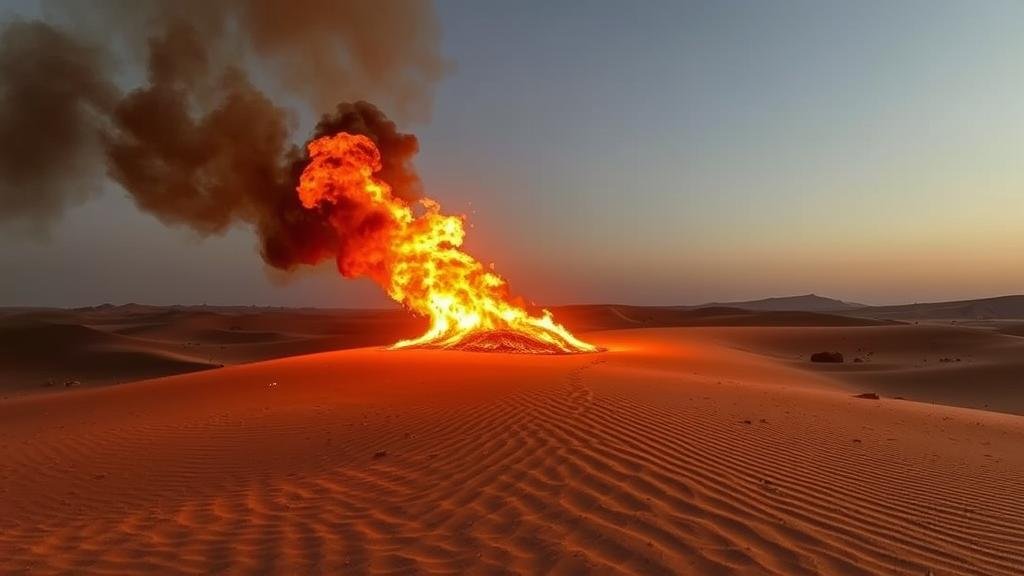Exploring the “Burning Sands,” a desert region in Africa where the ground is said to spontaneously combust.
Exploring the Burning Sands
The Burning Sands is a term that evokes intrigue and fear, synonymous with a desert landscape that seems to defy the laws of nature by spontaneously combusting. Located primarily in northern Africa, particularly the regions of Algeria and Libya, this arid expanse has fascinated researchers, adventurers, and locals alike.
Geographic and Environmental Context
The Burning Sands are primarily situated in the Sahara Desert, one of the largest deserts in the world, which spans approximately 9.2 million square kilometers across several countries including Algeria, Libya, Egypt, and Mali. This desert is characterized by vast stretches of dunes, rocky plateaus, and occasional oases. Its conditions include extreme temperatures, often exceeding 50 degrees Celsius (122 degrees Fahrenheit) in the summer months.
One notable area within this region is the Tayr Artoucha, an uninhabited desert terrain in Libya, where spontaneous combustion phenomena are frequently reported. The land is largely made up of silica sand and clay, which can sometimes foster chemical reactions that lead to fire.
The Science Behind Spontaneous Combustion
Spontaneous combustion is a complex phenomenon that occurs when a material self-ignites without an external ignition source. In the Burning Sands, materials such as organic matter in shallow burial sites can heat up due to microbial decay and surrounding extreme temperatures. When this organic matter reaches its ignition point, combustion occurs, often creating small fires that can spread over the region.
For example, in 2020, researchers observed a series of small-scale fires in the vicinity of the Burning Sands due to surface temperatures rising sharply after an unusual heatwave. These fires appeared more frequently near areas with higher concentrations of decomposing vegetation, illustrating how natural chemical processes can give rise to dramatic phenomena.
Cultural Significance and Mysterious Legends
The Burning Sands have not only sparked scientific interest but have also given rise to numerous myths and legends throughout history. Local tribes, such as the Tuareg people, have woven tales of spirits that guard the desert, attributing the strange occurrences to supernatural forces. As one legend suggests, the fires are seen as a warning for those who dare venture too close, serving as a reminder of the deserts harshness and unpredictability.
Historically, explorers like Ibn Battuta, who traversed the Sahara in the 14th century, documented encounters with fiery patches of ground, describing them as dangerous traps to be avoided. Such accounts have contributed to the mystique of the Burning Sands and their reputation as a place of peril.
Current Investigations and Research
Modern scientific research into the Burning Sands often focuses on understanding the ecological and geological implications of the region. In collaboration with local universities, scientists from the University of Algiers have initiated field studies to monitor temperature variations, soil composition, and potential gases emitted from these spontaneous fires.
In 2021, satellite imagery was employed to track thermal anomalies indicative of combustion. e studies provided invaluable data, revealing that about 5% of the area experiences anomalous heat patterns, suggesting a complex interplay of natural and environmental factors contributing to the phenomenon. This research is vital not only for understanding fire dynamics but also for evaluating the broader ecological impacts on the desert habitat.
Challenges and Considerations
While the Burning Sands may captivate attention, it also poses significant hazards. The spontaneous combustion can lead to unintended consequences for local wildlife, affecting their habitat and food sources. Also, human activity, such as oil exploration and tourism, could inadvertently ignite more extensive wildfires, as indicated by studies on human impact in arid ecosystems.
Conclusion and Actionable Takeaways
Exploring the Burning Sands invites both caution and curiosity. With the ongoing research uncovering the science behind spontaneous combustion and its ecological implications, the need for preservation and mitigation strategies becomes paramount. Here are some actionable takeaways:
- Stay informed about natural phenomena in ecological areas, especially when planning to visit regions like the Sahara.
- Support research initiatives focusing on climate change and desert ecosystems to help preserve their unique environments.
- Recognize and respect local cultural narratives and practices related to natural hazards.
The Burning Sands, with their blend of danger and beauty, remind us of the Earths intricate systems and the mysteries still waiting to be unraveled in our natural world.



